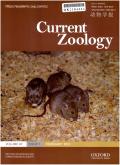猎物供应对蒙古萨克猎隼(Falco cherrug)繁殖运动模式的影响
IF 2
2区 生物学
Q2 ZOOLOGY
引用次数: 0
摘要
作为干旱草原上的顶级掠食者,萨克猎鹰在维持生态系统平衡方面发挥着至关重要的作用。了解它们在同种竞争和猎物可获得性方面的运动模式对保护它们非常重要。我们旨在了解繁殖秧鸡隼的运动模式与猎物可获得性之间的关系。在繁殖季节,我们使用卫星发射器对12只成年秧鸡进行了追踪。在整个繁殖季节,秧鸡猎鹰都表现出领地行为,相邻同种猎鹰之间的活动范围重叠极少。与雌性(平均=1,241公顷,中位数=554公顷)相比,雄性占据的区域更大(平均=2,397公顷,中位数=1,221公顷),而且在整个繁殖季节都保持一致。在雏鸟后期和羽化后依赖期,雌鸟的家域面积显著增加,这表明雌鸟摆脱了育雏的束缚。值得注意的是,我们发现雄鸟的家园范围大小与猎物的可获得性呈负相关。在啮齿动物密度高的地区,雄鸟占据的区域较小(平均 = 1,135 公顷,中位数 = 1,034 公顷),与啮齿动物密度低的地区(平均 = 6,815 公顷,中位数 = 6,516 公顷)形成鲜明对比。然而,在雌性家园范围大小与猎物可获得性之间没有观察到明显的关系。我们还注意到一些雌鸟出现了弃巢和过早分散的行为,这可能是受到了标记的障碍效应的影响。我们的研究结果为了解猎物的可获得性如何影响秧鸡隼的空间利用以及确定其成功繁殖的空间要求提供了宝贵的见解。这些知识对于保护和管理全球濒危的秧鸡隼至关重要,有助于制定有针对性的栖息地保护和资源管理战略。本文章由计算机程序翻译,如有差异,请以英文原文为准。
Influence of prey availability on the movement pattern of breeding saker falcons (Falco cherrug) in Mongolia
As an apex predator in arid steppe, saker falcon plays a crucial role in maintaining ecosystem balance. Understanding their movement patterns concerning conspecific competition and prey availability is important for their conservation. We aim to understand how movement pattern of breeding saker falcons relates to prey availability. Twelve adult sakers were tracked during the breeding seasons, using satellite transmitters. Throughout the breeding season, sakers exhibited territorial behaviour, with minimal overlap in range use among neighbouring conspecifics. Males occupied larger areas (mean = 2,397 ha, median = 1,221 ha), compared to females (mean = 1,241 ha, median = 554 ha), and it remained consistent throughout breeding season. Female home range size increased notably during late nestling stage and post-fledging dependence periods, indicating release from brooding constraints. Notably, we found a negative relationship between male home range size and prey availability. In high rodent density areas, males occupied smaller areas (mean = 1,135 ha, median = 1,034 ha), contrasting with low rodent density areas (mean = 6,815 ha, median = 6,516 ha). However, no significant relationship was observed between female home range size and prey availability. We also noted instances of nest abandonment and early dispersal behaviour in some females, potentially influenced by a handicapping effect of tagging. Our findings offer valuable insight into how prey availability shapes saker falcon space use and defines their spatial requirements for successful breeding. This knowledge is crucial for the conservation and management of globally endangered saker falcons, informing targeted habitat protection and resource management strategies.
求助全文
通过发布文献求助,成功后即可免费获取论文全文。
去求助
来源期刊

Current Zoology
Agricultural and Biological Sciences-Animal Science and Zoology
CiteScore
3.20
自引率
9.10%
发文量
111
审稿时长
6 weeks
期刊介绍:
About the Journal
Current Zoology (formerly Acta Zoologica Sinica, founded in 1935) is an open access, bimonthly, peer-reviewed international journal of zoology. It publishes review articles and research papers in the fields of ecology, evolution and behaviour.
Current Zoology is sponsored by Institute of Zoology, Chinese Academy of Sciences, along with the China Zoological Society.
 求助内容:
求助内容: 应助结果提醒方式:
应助结果提醒方式:


